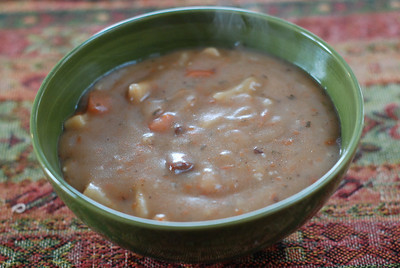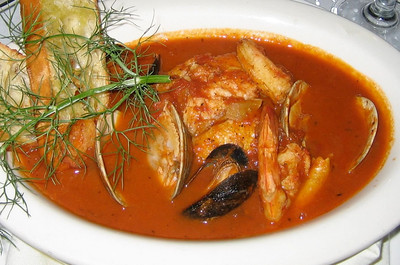It’s another cold morning on the East Coast, one that leaves me with little desire to step outside and into the latest snowstorm. On days like this I start rooting through my freezer, searching for ingredients for a warm, hearty stew. A one-pot wonder, stew consists of slow-cooked vegetables and fish or meat and the thick, savory liquid in which these ingredients simmer. Although I’ve consumed this nourishing dish since early childhood, it still remains my favorite way to add some heat to wintry afternoons.

Most stews were born out of necessity, using whatever items cooks had on hand. In the case of Irish stew, these staples included old, economically unviable sheep, or mutton, along with potatoes and onions. Beginning with mutton, Irish cooks of yore would place equal parts of meat, potato and onion in separate layers in a large casserole or kettle. They added a pinch of salt and pepper, poured in enough water to cover the layers, and clamped a lid on the kettle. They then set the concoction over an open fire and left it to simmer for two to three hours. Once the mutton and potatoes were tender and the stewing liquid had thickened and become infused with juices, dinner could be served.
Little of this recipe has changed since the stew became Ireland’s national dish in the early 1800s. Today, it is more commonly made with lamb, not mutton, and it simmers on a stove or cook top instead of an open fire. Otherwise, it’s the same nurturing repast from generations ago.

Similar to Irish stew, bouillabaisse began when French fishermen tossed their least worthwhile catch into big cooking pots. Along with the unmarketable fish and a generous dose of olive oil and water, they dropped onions, garlic, tomato and fennel into the cauldrons. Ladled into bowls and eaten with slices of grilled or crusty bread, aromatic bouillabaisse satisfied Marseille fishermen in the rawest weather.
Unlike its one-meat Irish counterpart, bouillabaisse demands a wide assortment of seafood. Firm-fleshed fish such as halibut and eel that are perfect for eating in chunks, flakier fish such as hake and sole that disintegrate and create a sumptuous broth, and inexpensive shellfish all find their way into the pot.
While Irish stew and bouillabaisse may be lovely, they aren’t the only dishes to make. When cooking for a carnivorous crowd, I might offer Spanish cocido with its salted meats, chicken, sausage and chickpeas, or Belgian waterzooi, which features chicken, leeks, potatoes and eggs. Likewise, I could dip into the delicacies of the American South and serve game-filled Brunswick stew or burgoo. The possibilities seem endless for almost every country warms up with its own take on stew.
BOUILLABAISSE
Serves 4 to 6
2 tablespoons olive oil
1 leek, cleaned and minced
1 celery stalk, washed and chopped
1 fennel bulb, quartered, cored and chopped
1/2 cup white onion, chopped
3/4 teaspoon salt
1 bay leaf
1/4 teaspoon saffron threads
1/4 teaspoon freshly ground black pepper
1/8 teaspoon dried basil
4 cloves garlic, grated
1/2 cup dry white wine
1 tablespoon tomato paste
1 1/2 cups canned chopped tomatoes with their juices
2 1/2 cups vegetable stock
3 tablespoons olive oil
12 littleneck clams, washed and scrubbed
6 mussels, scrubbed and beards removed
3/4 pound halibut, tilapia or flounder, cut into 1-inch chunks
1 pound shrimp, shelled and deveined
chopped fresh parsley, optional
In a large saute pan heat the oil. Add the leek, celery, fennel and onion, sprinkle the salt over top and saute the vegetables until softened but not browned, about 5 minutes. Add the bay leaf, saffron, black pepper, basil and garlic and saute for two minutes. Pour in the white wine and allow to simmer for 5 minutes before adding the tomato paste, tomatoes and the vegetable stock. Cover and simmer for 15 minutes. Taste and add more salt and ground black pepper if needed.
Place 3 tablespoons of olive oil in a large stockpot and heat on medium-high. Tumble in the clams and mussels, cover and cook for 2 to 3 minutes, shaking the pot periodically so that the shellfish cook evenly. Add the broth, bring to a boil and then reduce the heat to medium. Add the halibut, tilapia or flounder and allow to cook for another 2 minutes before tossing in the shrimp. Allow the fish and shellfish to cook for an additional 3 minutes or until done. Remove any unopened mussels and clams, sprinkle the optional chopped parsley over top and ladle into bowls. Serve with a baguette or crusty white bread.